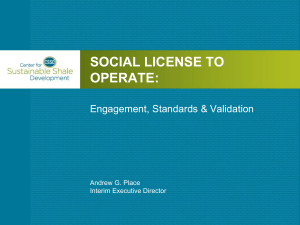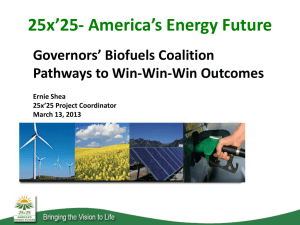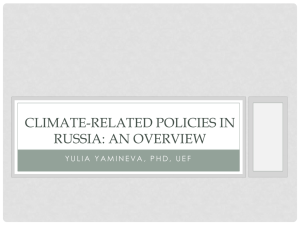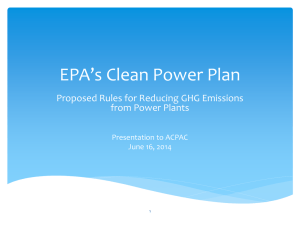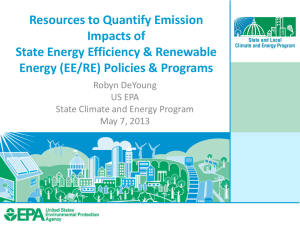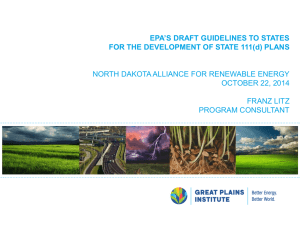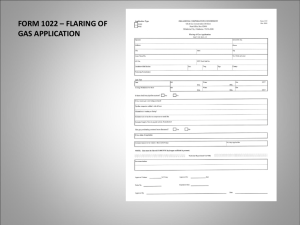Larkin_GCREAG_PPT_1_10_2013SP-4492860
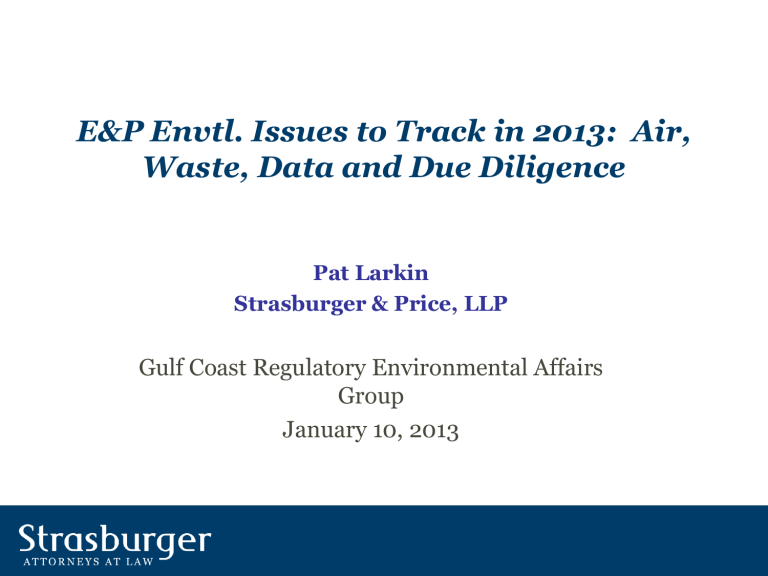
E&P Envtl. Issues to Track in 2013: Air,
Waste, Data and Due Diligence
Pat Larkin
Strasburger & Price, LLP
Gulf Coast Regulatory Environmental Affairs
Group
January 10, 2013
Overview: Numerous Issues to Track in
2013 (as always)
• Air Emissions – New Permitting and Controls Obligations for OGS’
• Public Data Reporting – Federal initiatives; States falling in line.
• Waste, Wastewater and Water Quality – disposal costs; GW diligence.
• Litigation and Miscellaneous Challenges – need to track cases, worst case outcomes.
• Managing Compliance and Enforcement Risks - need to define and eliminate enforcement exposures arising from these issues/developments.
Air Emissions Issues to Track in 2013:
• Aggregation of Emissions – Accumulating Federal Major Source Status
(Title V, MACTs)
• TCEQ PBR and Standard Permits – notifications and MSS PBR
• NSPS Subpart OOOO – Green Completions, Tank Controls and Obligation to Flare new VOC sources.
• Tex RR Commn SWR 32 : flaring permits and prohibitions
• RICE MACT – amended applicability and new compliance requirements
• State Ozone Controls targeting E&P operations – Ozone non-attainment areas may target VOC from E&P
Air Emissions Issues to Track in 2013:
• Aggregation of Emissions
Issue: States may use case-by-case criteria to aggregate “adjacent” and related air sources to apply “major source” Title V and MACTs
– States using narrow defn of “adjacent” (1/4 mi. by TCEQ/PA)
– EPA (or enviro-activists) may disagree/demand aggregation of dispersed sources.
– If broad aggregation achieved, PBR/SP programs could be voided.
Status: 6 th Cir. Fed Appeals Court in Summit v. EPA (8/7/12) rejected EPA aggregation of OGS sites in 8 mile radius, EPA’s emphasis on inter-dependence to define
“adjacency.”
– Summit does not void EPA position outside 6 th Cir. States (KY, MI, OH, TN)
Risks to Monitor:
– EPA may revise aggregation guidance – may use NAAQS impacts (NOX/SOX) as basis for using functional relationship to define adjacency.
– EPA/enviros could assert that non-aggregation allows NAAQS exceedences.
– EPA could amend 40 CFR 52.21(b)(6)
Air Emissions Issues to Track in 2013:
TCEQ Oil & Gas PBR and Standard Permits – MSS Emissions
• Current O&G PBR/SPs do not include MSS emissions in authorized emissions.
– ex. SP for Barnett Shale counties which
• requires MSS emissions in applicability limits
• Includes MSS BMPs as enforceable permit terms
• TCEQ will issue a draft MSS PBR rule for 2/2013 Commn. Agenda
– Intended to be a “bolt on” addition to existing permits – no additional quantification of MSS emissions to show applicability/authorization.
Issues to track in MSS PBR rulemaking:
• BMPs – recommendations or mandates?
• Stacking of PBRs and emissions [additional 25 tpy?]
• Will PBR define the line between MSS v. reportable “upset” emissions?
• Will PBR include requirements to address MSS in non-attainment areas?
• How will MSS PBR coordinate with prior MSS claimed in other PBRs/SPs?
Air Emissions Issues to Track in 2013:
NSPS Subpart OOOO
Basic Requirements:
• Controls required on new Nat Gas facilities (start-up or modified) after 8/15/12.
• Email notice to EPA/state 2 days prior to well completion/flowback VOC emissions from each hydro-fracked well(s).
• VOC must be controlled by RECs after 1/1/2015.
• VOC must be flared from startup, until 1/2015
– Venting allowed if flaring prohibited by local/state law for safety purposes.
Additional Controls for Storage Vessel VOCs and other affected sources at sites.
• Pneumatic Controllers must reduce VOC to max. of 6 cu. ft./hr.
• Vessels w/ 6tpy VOC must control to 95% reduction
– Affected “storage vessels” are non-temporary tanks (at site >180 days)
– “Existing” vessels must control VOC (and HAPs) by 10/13.
– “New” vessels – have 30 days to make 6 TPY trigger calculation, 30 days to install controls
Air Emissions Issues to Track in 2013:
NSPS Subpart OOOO
• API, TXOGA and Enviros suits:
– API seeking
• extension of Vessel VOC control deadline
– EPA estimates 600 “affected” vessels need controls, API estimate: several 1000
• Clarification of venting prohibition during flare controls period
– Sierra Club and State AGs (NE States)
• Demanding formal EPA position on “methane endangerment” and that CH4 be controlled in NSPS.
• Related suit challenging lack of controls on other E&P related air toxics in NESHAP rule
Watch for:
• Local and State SIP rules prohibiting flaring that may trigger SO2 non-attainment (or
Non-attainment area NSR permitting)
• An EPA voluntary stay/extension of compliance dates (but don’t count on it)
Air Emissions Issues to Track in 2013:
Tex RR Commn SWR 32 : venting & flaring permits and prohibitions
• 16 TAC Sec. 3.32: All nat gas must be recovered and used if it can be readily measured by routine metering devices.
– Exceptions: blowdown, tank vapor, fugitives, completion-related emmns.
– Must flare if releases >24 hrs.
– May vent if <24 hr. release – unless prohibited by law or safety
– Maximum release
• 10 days post-completion
• Administrative extension with cause – max. 180 days
• RRC Hearing required if request >180 day extension
• Commission Increasing Enforcement of SWR 32 - if no permit/extensions obtained
– NOVs auto-mailed if Production Report shows flaring without SWR 32 Permit
– Daily penalties of up to $10k/ well
– Failure to correct/progress on collection/connection = cause for Severance Letter
• RRC Commnr. Porter announced Initiative to “Modernize” Flare Rules
– No draft rule to-date
• Rep. Keffer, Chair of Texas House Energy Res. Committee –intends to submit flaring legislation
(Austin 82d Leg. Session underway!)
Watch For: Legislation/RRC Rules to specifically invoke NSPS O4“safety exception” to allow venting:
• limit flaring where TCEQ SIP rules/SO2 limits violated?
• Possibly adopt NSPS control technology for extended venting?
Air Emissions Issues to Track in 2013:
RICE MACT – amended applicability and new 2013 compliance requirements
• Initial RICE MACT – limited to Major Sources w/ > 500 HP3
• 2010 RICE MACT update imposes controls and/or O&M requirements across spectrum of RICE
(Area Sources, Emerg. Engines, sizes from <100 HP - >500HP)
• Next control-installation deadline: May, 2013
• To identify potentially required controls and compliance obligations for each engine, operator will need to confirm and cross-reference all of these factors:
– HAP Major source or an Area Source?
– Engine size
– Engine type (lean/rich feed, 2 or 4 stroke, etc.)
– Fuel type
– Annual hours of service
– Date first in service
– Emergency or Continuous ops.
• More than 70 interrelated applicability scenarios may be considered for each engine.
Watch For: May 3 will come quickly for RICE operators
Public Data Reporting – 2013 Compliance and
Rulemaking
EPCRA Toxic Release Inventory (TRI)
• The TRI regulations require most industries to report to the EPA significant uses and releases of toxic substances.
• Oil and gas facilities are not required to report to the TRI.
• On 10/24/2012, the Environmental Integrity Project filed a formal petition with the US EPA – requesting that EPA begin rulemaking to require TRI data collection and reporting by E&P operators.
• TRI Reporting would require calculation/reporting, by site, of air, water, waste releases of up to
600 chemicals, if above threshold quantities.
Ongoing Development of State-Required fracking fluid disclosures –
• California
– Cal-DOGGR “Discussion Draft” of Fracking Rule released December 18
– SCAQMD Proposed Fracking Air emissions Rulemaking – fluid content disclosures and green completions
• Ohio, Colorado, Utah – Frack Fluid Disclosure Rules – FRACFOCUS posting
Watch For: TRI rulemaking; mandated public posting of fluids, air emissions and GWM data, and any complaints.
Waste, Wastewater and Water Quality
UIC Disposal Standards
• State GW Regulators Assn advocating reviews and update of state UIC requirements:
-Include seismicity impact analysis
-Incorporate EPA Diesel Fracking permitting Guidance
• Waste and Wastewater Recycling
- TxRRC promulgates water and mud recycling regulations – demand for services?
-EPA considering return of E&P waste to RCRA Sub. C program
- manage E&P waste as HW – manifesting
- disposal in UIC Class I wells: Class II re-permitting/closures?
-E&P Waste and Wastewater recycling
-Demand and complexity greatly increase (no land application?)
- RCRA Status Subject to Congressional Approval – No way!
-No legislation needed for RCRA Subtitle D. regulation of E&P wastes.
Watch For: UIC, RCRA devts. (state or federal) could quickly boost water mgmt. costs
• e.g., Ohio Exec Order imposes UIC seismicity, integrity and monitoring standards on Class
II disposal wells.
Waste, Wastewater and Water Quality
Site-Focused Protection of Water Quality
• Pre-Lease GW Monitoring – 3 states with GWM, 2 w/ post-drill montg.
• Setback Requirements – variable per relative urbanization
•Recent State Proposals & Adoptions
• Colorado GWM Rule proposed Oct., 2012; Final Rule Issued January 7, 2012.
• requires sampling up to four water wells within one-half mile of a new oil and gas well prior to drilling,
• requires samples of wells post-completion at 6-12 months and after 5-6 years, a requirement unprecedented among other states.
• Proposed Setbacks Rule issued Nov. 9, 2012
• Proposed Rule in Hearings before COGCC (1/7 – 1/10).
• Alaska - GWM Rule proposed Dec. 20, 2012 – pre and post completion monitoring.
• Ohio – S.B. 315 (6/2012) mandates pre-drill GWM w/in 1500 ft. of site
• California DOGGR “Discussion Draft ” of Rule issued 12/18/12
• focus on well integrity analysis and testing
• no set-back or GWM requirements
Watch For: More state GWM requirements - two’s a pattern, three is a trend!
Litigation and Miscellaneous
Litigation and Rulemaking Petitions
• NSPS OOOO and NESHAP – Methane Endangerment finding
• Prairie Chicken & Earless Lizard Petitions – possible US FWS rulemaking to protect E&P habitats
• TRI/EPCRA Petition – annual report of all toxics from E&P sites
• NEPA/CEQA litigation v. Cal. DOGGR – no frack permits without EIS of cumulative impacts
• LNG Terminal Challenges (LA & MD) – Sierra Club demands EIS of increased nat gas production
Preemption Litigation: States challenge fracking bans by NY, PA towns; City Setback Ordinance in
Colo. Springs
Activist Litigation Focuses:
• Block Markets – LNG cases
• Strand Wells – FERC Pipeline cases
• Limit or Prohibit Flaring of Stranded Gas – State AG’s NSPS Suit to include CH4 in NSPS
• Endangered Species Listing in Drilling Habitat – Chicken/Lizard
• Require NEPA review of Fracking Cumulative Impacts - Delay permit programs and block issuance of drill permits
Watch For: be aware of “live” cases in operating jurisdictions and worst-case scenarios for each!
Managing Compliance and Enforcement Risks
Biggest Enforcement Risks:
• Acquired Assets – Hidden Non-Compliance and Penalty Liability!
• Uncertainty of Litigated or Conflicting Applicable Standards!
– E.g. – NSPS OOOO: Tanks in? – REC needed now? –Flaring required by NSPS but possibly prohibited by NAAQS?
Solutions and Strategy:
• Compliance Audit to Establish Penalty Immunity (right or wrong, no penalty and time to plan and comply).
– Texas Environmental Audit Statute
• Notice, Audit, Disclose, Correct w/in reasonable time = Penalty Immunity
– USEPA Audit and Self-Disclosure Policy
• Prompt disclosure (21 days), EBEN and prompt corrections .
Managing Compliance and Enforcement Risks
Coordinate Due Diligence and Compliance/Immunity Auditing:
• Existing Well Assets
-Air Emissions: Permitted and Controlled?
(Tanks, Flares, RICE in use, Progress on REC use, State Aggregation policy, MSS strategy, capacity upgrades trigger permit amendments…?)
-Flowback water management?
(UIC permitted, diesel guidance apply, recycling service available/permitted…?)
-Water Quality Impacts
(complaints, baseline/monitoring of supply wells, abandoned wells ID’d, fluid disclosures filed,…?)
• Acquiring New Drilling Sites
-Pre-construction Air Permitting (Minor Source v. Aggregation potential; REC,
VRU and flaring plans…?)
-Local controls: (setbacks met, impact fees, bans or preemption established…?)
-Fluid Disposal Strategy: (Formulation require UIC permit, adequate water supply…?)
-Pre-lease GW Water Monitoring: (Mandatory v. Risk management baseline?)
Q&A?
Patrick J. Larkin
Partner and Practice Leader, Environmental Practice Group
Strasburger & Price, L.L.P.
901 Main Street
Suite 4400
Dallas, Texas 75202
Patrick.larkin@strasburger.com
T: 214-651-2132 • Cell: 214-770-3881 • Fx: 214-659-4075

